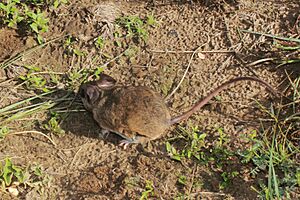Perote mouse facts for kids
Quick facts for kids Perote mouse |
|
|---|---|
 |
|
| Conservation status | |
| Scientific classification | |
| Genus: |
Peromyscus
|
| Species: |
bullatus
|
The Perote mouse (scientific name: Peromyscus bullatus) is a small rodent that looks a bit like a deer mouse. It belongs to the Cricetidae family, which includes many types of mice and hamsters. You can only find this special mouse in Mexico.
Contents
What Does the Perote Mouse Look Like?
The Perote mouse is about the size of a small rat. It measures 18 to 22 centimetres (7.1 to 8.7 in) from its nose to the tip of its tail. Its tail is hairy and usually longer than its body, measuring 9 to 12 centimetres (3.5 to 4.7 in).
This mouse has a tawny-ochre (yellowish-brown) color. Its belly and underside are creamy white. The middle of its back is a bit darker than the rest of its fur. The sides of its head are grey.
Special Features of the Perote Mouse
It can be hard to tell the Perote mouse apart from other mice in its group, Peromyscus. But there are a few key differences. Its ears are at least 2 mm (0.08 in) larger than its back feet.
Inside its skull, it has special, puffed-up bones called auditory bullae. These bones help the mouse hear very well. This excellent hearing helps the Perote mouse quickly notice predators that might be nearby.
Where Does the Perote Mouse Live?
The Perote mouse lives only in a specific area of Mexico. This area is called the Oriental Basin. It includes parts of western Veracruz, central Puebla, and the far eastern side of Tlaxcala.
This region is quite small. It is located at a high elevation, between 2,250 and 2,500 metres (7,380 and 8,200 ft) above sea level. It is also close to the city of Perote.
Perote Mouse Habitat
The Oriental Basin has mostly grasslands and dry, scrubby plants. There are also some small patches of pine and fir forests. The Perote mouse prefers areas with sandy soil. It also likes places where a few juniper or yucca trees grow.
The Perote mouse needs a very specific type of home. Its living area is small, and its population is shrinking. Because of these reasons, the Perote mouse is considered critically endangered. This means it is at a very high risk of disappearing forever.


